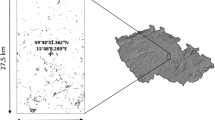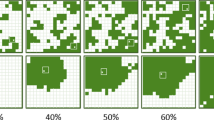Abstract
Habitat availability—or how much habitat species can reach at the landscape scale—depends primarily on the percentage of native cover. However, attributes of landscape configuration such as the number, size and isolation of habitat patches may have complementary effects on habitat availability, with implications for the management of landscapes. Here, we determined whether, and at which percentages of native cover, the number, size and isolation of patches contribute for habitat availability. We quantified habitat availability in 325 landscapes spread across the state of Rio de Janeiro, in the Atlantic Forest hotspot, with either high (>50 %), intermediate (50–30 %), low (30–10 %) or very low (<10 %) percentage of native cover, and for six hypothetical species differing in inter-patch dispersal ability. Above 50 % of native cover, the percentage of cover per se was the only determinant of habitat availability, but below 50 % the attributes of landscape configuration also contributed for habitat availability. The number of patches had a negative effect on habitat availability in landscapes with 50–10 % of native cover, whereas patch size had a positive effect in landscapes with <10 % of native cover. The different species generally responded to the same set of landscape attributes, although to different extents, potentially facilitating decision making for conservation. In landscapes with >50 % of native cover, conservation actions are probably sufficient to guarantee habitat availability, whereas in the remaining landscapes additional restoration efforts are needed, especially to reconnect and/or enlarge remaining habitat patches.



Similar content being viewed by others
References
Andrén H (1994) Effects of habitat fragmentation on birds and mammals in landscapes with different proportions of suitable habitat: a review. Oikos 71:355–366
Arnold TW (2010) Uninformative parameters and model selection using Akaike’s information criterion. J Wildl Manage 74:1175–1178
Awade M, Boscolo D, Metzger JP (2012) Using binary and probabilistic habitat availability indices derived from graph theory to model bird occurrence in fragmented forests. Landscape Ecol 27:185–198
Bender DJ, Fahrig L (2005) Matrix structure obscures the relationship between interpatch movement and patch size and isolation. Ecology 86:1023–1033
Bender DJ, Contreras TA, Fahrig L (1998) Habitat loss and population decline: a meta-analysis of the patch size effect. Ecology 79:517–533
Bolker BM (2008) Ecological models and data in R. Princeton University Press, Princeton
Bowman J, Jaeger JAG, Fahrig JL (2002) Dispersal distance of mammals is proportional to home range size. Ecology 83:2049–2055
Burnham PB, Anderson DR (2002) Model selection and multimodel inference: a practical information-theoretic approach. Springer, New York
Chetkiewicz CB, St Clair CC, Boyce MS (2006) Corridors for conservation: integrating pattern and process. Annu Rev Ecol Evol Syst 37:317–342
Crouzeilles R, Lorini ML, Grelle CEV (2010) Deslocamento na matriz para espécies da mata Atlântica e a dificuldade da construção de perfis ecológicos. Oecol Aust 14:875–903
Crouzeilles R, Lorini ML, Grelle CEV (2013) The importance of using sustainable use protected areas for functional connectivity. Biol Conserv 159:450–457
Decout S, Manel S, Miaud C, Luque S (2012) Integrative approach for landscape-based graph connectivity analysis: a case study with the common frog (Rana temporaria) in human-dominated landscapes. Landscape Ecol 27:267–279
ESRI (2008) ArcView 9.3. ESRI, Redlands, CA
Ewers RM, Didham RK (2006) Confounding factors in the detection of species responses to habitat fragmentation. Biol Rev Camb Philos Soc 81:117–142
Fahrig L (2001) How much habitat is enough? Biol Conserv 100:65–74
Fahrig L (2003) Effects of habitat fragmentation on biodiversity. Annu Rev Ecol Syst 34:487–515
Fidalgo ECC, Uzêda MC, Bergallo HG, Costa TCC, Abreu MB (2009) Distribuição dos remanescentes vegetais no Estado do Rio de Janeiro. In: Bergallo HB, Fidalgo ECC, Rocha CFD, Uzêda MC, Costa MB, Alves MA, Van Sluys M, Santos MA, Costa TCC, Cozzolino ACR (eds) Estratégias e ações para a conservação da biodiversidade no Estado do Rio de Janeiro. Instituto Biomas, Rio de Janeiro, pp 91–99
Fischer J, Lindenmayer DB (2007) Landscape modification and habitat fragmentation: a synthesis. Global Ecol Biogeogr 16:265–280
Gardner TA, Barlow J, Chazdon R, Ewers R, Harvey CA, Peres CA, Sodhi N (2009) Prospects for tropical forest biodiversity in a human-modified world. Ecol Lett 12:561–582
Henle K, Davies KF, Kleyer M, Margules C, Settele J (2004) Predictors of species sensitivity to fragmentation. Biodivers Conserv 13:207–251
Hubbell SP (2001) The unified neutral theory of biodiversity and biogeography. Princeton University Press, Princeton
Laurance WF (2009) Conserving the hottest of the hotspots. Biol Conserv 142:1137
Lindenmayer DB et al (2008) A checklist for ecological management of landscapes for conservation. Ecol Lett 11:78–91
Luque S, Saura S, Fortin MJ (2012) Landscape connectivity analysis for conservation: insights from combining new methods with ecological and genetic data. Landscape Ecol 27:153–157
MacArthur RH, Wilson EO (1967) The theory of island biogeography. Princeton University Press, Princeton
Martensen AC, Ribeiro MC, Banks-Leite C, Prado PI, Metzger JP (2012) Associations of forest cover, fragment area, and connectivity with Neotropical understory bird species richness and abundance. Cons Biol 26:1100–1111
Metzger JP, Décamps H (1997) The structural connectivity threshold: an hypothesis in conservation biology at the landscape scale. Acta Oecol 18:1–12
Pardini R, Bueno AA, Gardner TA, Prado PI, Metzger JP (2010) Beyond the fragmentation threshold hypothesis: regime shifts in biodiversity across fragmented landscapes. PLoS ONE 5(10):e13666
Pascual-Hortal L, Saura S (2006) Comparison and development of new graph-based landscape connectivity indices: towards the priorization of habitat patches and corridors for conservation. Landscape Ecol 21:959–967
Ponzoni F, Hirota MM, Rosa MR (2012) Mapeando os remanescentes florestais na Mata Atlântica brasileira. In: Paese A, Uezu A, Lorini ML, Cunha A (eds) Conservação da biodiversidade com SIG. Oficina de Textos, São Paulo, pp 157–178
Püttker T, Bueno AA, Barros CS, Sommer S, Pardini R (2011) Immigration rates in fragmented landscapes—empirical evidence for the importance of habitat amount for species persistence. PLoS ONE 6(11):e27963
R Development Core Team (2010) R: a language and environment for statistical computing. R Foundation for Statistical Computing, Viena. http://www.R-project.org
Ribeiro MC, Metzger JP, Martensen AC, Ponzoni FJ, Hirota MM (2009) Brazilian Atlantic Forest: how much is left and how is the remaining forest distributed? Implications for conservation. Biol Conserv 142:1141–1153
Rodrigues RR, Lima RAF, Gandolfi S, Nave AG (2009) On the restoration of high diversity forests: 30 years of experiences in the Brazilian Atlantic forest. Biol Conserv 142:1242–1251
Sarkar S, Illoldi-Rangel P (2010) Systematic conservation planning: an updated protocol. Nat Conservação 8:19–26
Saura S, Pascual-Hortal L (2007) A new habitat availability index to integrate connectivity in landscape conservation planning: comparison with existing indices and application to a case study. Landscape Urban Plan 83:91–103
Saura S, Rubio L (2010) A common currency for the different ways in which patches and links can contribute to habitat availability and connectivity in the landscape. Ecography 33:523–537
Saura S, Torné J (2009) Conefor Sensinode 2.2: a software package for quantifying the importance of habitat patches for landscape connectivity. Environ Model Softw 24:135–139
SOS Mata Atlântica, INPE (2010) Atlas dos remanescentes florestais da Mata Atlântica—Período de 2008–2010—Dados parciais dos estados avaliados até maio de 2010. Fundação SOS Mata Atlântica, São Paulo
Vetter D, Hansbauer MM, Végvári Z, Storch I (2011) Predictors of forest fragmentation sensitivity in Neotropical vertebrates: a quantitative review. Ecography 34:1–8
Villard M, Metzger JP (in press) Beyond the fragmentation debate: a conceptual model to predict when habitat configuration really matters. J Appl Ecol
Whitmee S, Orme CDL (2013) Predicting dispersal distance in mammals: a trait-based approach. J Anim Ecol 82:211–221
With KA, King AW (1999) Dispersal success on fractal landscapes: a consequence of lacunarity thresholds. Landscape Ecol 14:73–82
Zeileis A, Cribari-Neto F, Gruen B, Kosmidis I (2012) Package “betareg”. http://cran.r-project.org/web/packages/betareg/betareg.pdf. Accessed 15 Apr 2012
Acknowledgments
We thank Camila S. Barros for comments and suggestions in an early version of the manuscript. Jean P. Metzger, Leandro R. Tambosi and one anonymous reviewer also made valuable suggestions to the manuscript. Support was provided by CAPES, CNPq and FAPERJ (scholarships to RC and JAP), CAPES/FAPERJ/PNPD (post-doctoral fellowships to MSLF and MLL), CNPq (research productivity fellowship to CEVG), FAPERJ (JCE to CEVG), CAPES, CNPq and Conservation International-Brazil that provided financial support, and ESRI that provided a free version of ArcGis 9.3.1.
Author information
Authors and Affiliations
Corresponding author
Rights and permissions
About this article
Cite this article
Crouzeilles, R., Prevedello, J.A., Figueiredo, M.S.L. et al. The effects of the number, size and isolation of patches along a gradient of native vegetation cover: how can we increment habitat availability?. Landscape Ecol 29, 479–489 (2014). https://doi.org/10.1007/s10980-013-9978-6
Received:
Accepted:
Published:
Issue Date:
DOI: https://doi.org/10.1007/s10980-013-9978-6




